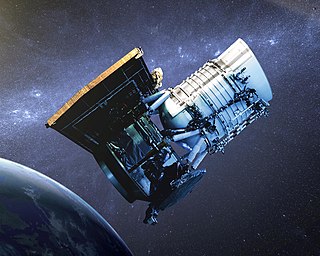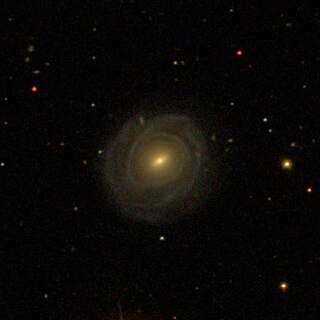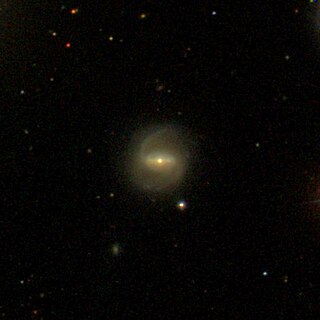
The Infrared Astronomical Satellite (IRAS) was the first space telescope to perform a survey of the entire night sky at infrared wavelengths. Launched on 25 January 1983, its mission lasted ten months. The telescope was a joint project of the United States (NASA), the Netherlands (NIVR), and the United Kingdom (SERC). Over 250,000 infrared sources were observed at 12, 25, 60, and 100 micrometer wavelengths.

The Two Micron All-Sky Survey, or 2MASS, was an astronomical survey of the whole sky in infrared light. It took place between 1997 and 2001, in two different locations: at the U.S. Fred Lawrence Whipple Observatory on Mount Hopkins, Arizona, and at the Cerro Tololo Inter-American Observatory in Chile, each using a 1.3-meter telescope for the Northern and Southern Hemisphere, respectively. It was conducted in the short-wavelength infrared at three distinct frequency bands near 2 micrometres, from which the photometric survey with its HgCdTe detectors derives its name.
Colin Alistair Ronan FRAS was a British author and specialist in the history and philosophy of science.
Luminous infrared galaxies or LIRGs are galaxies with luminosities, the measurement of brightness, above 1011 L☉. They are also referred to as submillimeter galaxies (SMGs) through their normal method of detection. LIRGs are more abundant than starburst galaxies, Seyfert galaxies and quasi-stellar objects at comparable luminosity. Infrared galaxies emit more energy in the infrared than at all other wavelengths combined. A LIRG's luminosity is 100 billion times that of the Sun.

Wide-field Infrared Survey Explorer is a NASA infrared astronomy space telescope in the Explorers Program. It was launched in December 2009, and placed in hibernation mode in February 2011, before being re-activated in 2013 and renamed the Near-Earth Object Wide-field Infrared Survey Explorer (NEOWISE). WISE discovered thousands of minor planets and numerous star clusters. Its observations also supported the discovery of the first Y-type brown dwarf and Earth trojan asteroid.
2114 Wallenquist, provisional designation 1976 HA, is a Themistian asteroid from the outer region of the asteroid belt, approximately 28 kilometers in diameter. It was discovered by Swedish astronomer Claes-Ingvar Lagerkvist at the Australian Mount Stromlo Observatory near Canberra, on 19 April 1976.
3915 Fukushima, provisional designation 1988 PA1, is a carbonaceous asteroid from the inner regions of the asteroid belt, approximately 21 kilometers in diameter.

The Quintuplet cluster is a dense cluster of massive young stars about 100 light years from the Galactic Center (GC). Its name comes from the fact it has five prominent infrared sources residing in it. Along with the Arches Cluster it is one of two in the immediate GC region. Due to heavy extinction by dust in the vicinity, it is invisible to optical observation and must be studied in the X-ray, radio, and infrared bands.
Mervyn Archdall Ellison was an Irish astronomer. He was recognized as a world authority on solar physics and the effect of solar flares on the Earth.

LL Pegasi is a Mira variable star surrounded by a pinwheel-shaped nebula, IRAS 23166+1655, thought to be a preplanetary nebula. It is a binary system that includes an extreme carbon star. The pair is hidden by the dust cloud ejected from the carbon star and is only visible in infrared light.
HD 76151 is a high proper motion, G-type main sequence star in the constellation of Hydra 56.70 light years from earth. It has an apparent visual magnitude of approximately 6.00. An infrared excess has been detected around this star, most likely indicating the presence of a circumstellar disk at a radius of 7.9 AU. The temperature of this dust is 99 K.

Kappa2 Coronae Australis, Latinized from κ2 Coronae Australis, is the primary of a probable binary system located in the southern constellation Corona Australis. It is visible to the naked eye as a bluish-white hued star with an apparent visual magnitude of 5.59. The distance to this star is roughly 710 light years based on Gaia DR3 parallax measurements. The radial velocity is poorly constrained, but the star appears to be moving closer with a radial velocity of around −15 km/s. At its current distance, Kappa2 CrA's brightness is diminished by 0.45 magnitudes due to interstellar dust.
IRC −10414 is a red supergiant and runaway star in the constellation Scutum, a rare case of a red supergiant with a bow shock.

NGC 470 is a spiral galaxy in the constellation Pisces. Located approximately 91 million lightyears from Earth, it was discovered by Friedrich Wilhelm Herschel in 1784. The galaxy also weakly interacts with NGC 474.

LP Andromedae is a carbon star in the constellation Andromeda. It is also a Mira variable whose mean apparent visual magnitude is 15.12 and has pulsations with an amplitude of 1.50 magnitudes and a period of 614 days.
2MASS J12195156+3128497 is a rapidly-rotating brown dwarf of spectral class L8, located in the constellation Coma Berenices about 66 light-years from Earth. With a photometrically measured rotation period of 1.14 hours, it is one of the fastest-rotating known brown dwarfs announced by a team of astronomers led by Megan E. Tannock in March 2021. With a rotational velocity of about 80 km/s (50 mi/s), it is approaching the predicted rotational speed limit beyond which it would break apart due to centripetal forces. As a consequence of its rapid rotation, the brown dwarf is slightly flattened at its poles to a similar degree as Saturn, the most oblate planet in the Solar System. Its rapid rotation may enable strong auroral radio emissions via particle interactions in its magnetic field, as observed in other known rapidly-rotating brown dwarfs.

NGC 5910 is an elliptical galaxy located about 540 million light-years away in the constellation Serpens. It was discovered by astronomer William Hershel on April 13, 1785. NGC 5910 is also a strong radio source with a conspicuous nuclear jet.

NGC 4326 is a barred spiral galaxy with a ring located about 330 million light-years away in the constellation Virgo. It was discovered by astronomer William Herschel on April 13, 1784, who described it as "vF, S, R, bM, 1st of 3". It is a large galaxy, with a diameter of around 200,000 ly (61 kpc) making it nearly twice the size of the Milky Way. NGC 4326 is also classified as a LINER galaxy. Despite being listed in the Virgo Cluster catalog as VCC 623, it is not a member of the Virgo Cluster but instead a background galaxy.

NGC 4333 is a barred spiral galaxy with a ring structure located about 330 million light-years away in the constellation Virgo. It was discovered by astronomer William Herschel on April 13, 1784, who described it as "F, pS, R, bM, 2nd of 3". NGC 4333 is also classified as a LINER galaxy. Despite being listed in the Virgo Cluster catalog as VCC 637, it is not a member of the Virgo Cluster but instead a background galaxy.










